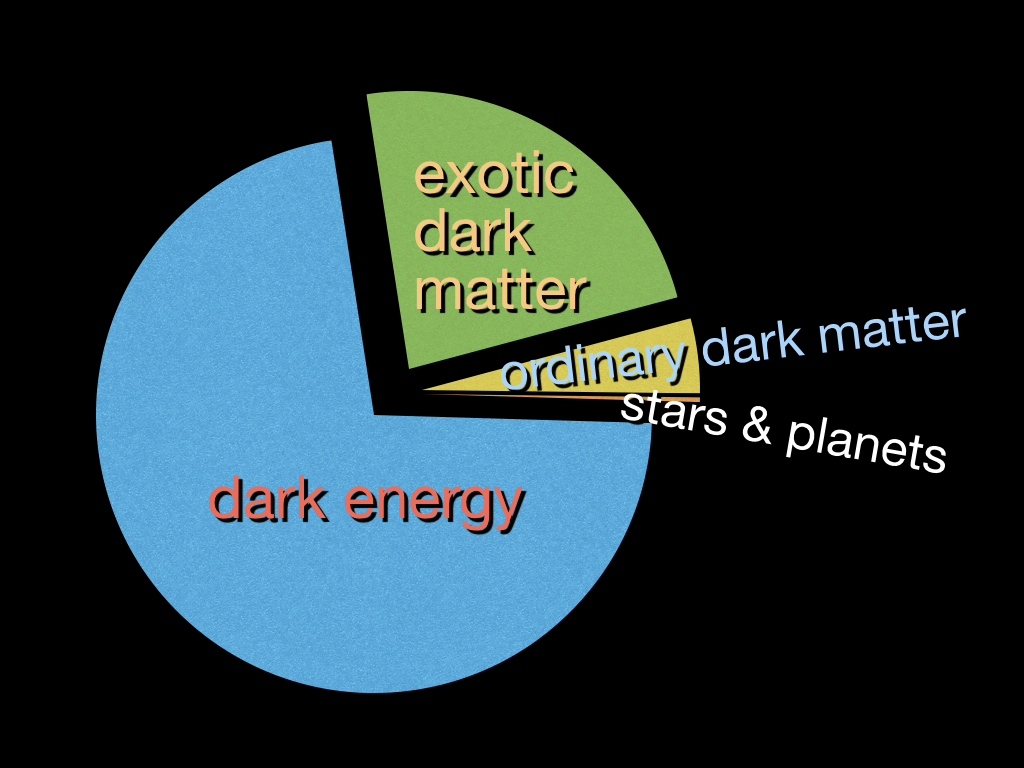More Anthropic Reasons for the Extreme Fine-Tuning of Dark Energy
Years ago, in a paper published in the Astrophysical Journal, theoretical physicist Lawrence Krauss referred to dark energy as presenting “the most extreme fine-tuning problem known in physics.”1 Dark energy is energy embedded in the universe’s space surface that makes up about 70 percent of all the stuff of the universe (see figure 1). Krauss determined that the fine-tuning level is more extreme than one part in 10120! He has been joined by several other theoretical physicists who conclude that the required fine-tuning of dark energy is “the most difficult problem in physics.”2 The obvious question is does this most difficult problem point to a causal agent with the capacity to fine-tune to a degree far, far beyond anything we humans are capable of manifesting?
Figure 1: Relative abundance components of the universe. Diagram credit: Hugh Ross
Dark energy is the dominant factor controlling cosmic expansion. The larger the constant or constants governing dark energy, the more rapidly the universe expands from the cosmic creation event.
If the constant(s) governing dark energy is much larger than what we observe, then galaxies and stars will never form. If the constant(s) governing dark energy is much smaller than what we observe, then too much of the matter of the universe collapses into black holes and neutron stars.
Galaxies and stars of any kind will not form in the universe if the value of the dark energy constant, Λ, is greater than a hundred times more than what astronomers observe. However, a team of nine astrophysicists led by Luke Barnes used detailed computer simulations to demonstrate that increases in the value of Λ, even by a factor of 10–20 times, has only a small effect on star formation history and efficiency.3 The reason for such a small effect is that the rate of star formation in our universe peaks when the universe is about 3.5 billion years old, which is well before Λ would begin to accelerate the expansion rate of the universe. In fact, Barnes et al. showed that galaxies and stars will form in the universe even for values of Λ as high as 50 times greater than the observed value. This factor of 50 caused some astronomers to question the anthropic nature of Λ, the implication that Λ was personally fine-tuned (designed) to an extreme degree to make possible the existence of human beings in the universe.
Now, two papers have been published that establish that Λ must be fine-tuned to a very extreme degree after all. In the most recent issue of the journal Astrobiology, a team of six Japanese astrophysicists led by Tomonori Totani provides calculations that show that Λ must be as small as what we observe to prevent advanced life from being wiped out by lethal radiation from nearby supernovae (see figure 2).4 Totani’s team demonstrated that as the value of Λ increases from the observed value to 50 times the observed value, the density of stars in the universe proportionately increases. With an increase in the density of stars comes an increase in the number of nearby supernova eruptions in the vicinity of a planet that could potentially support advanced life.
Figure 2: Supernova 1994D in the Galaxy NGC 4536. At the height of its supernova eruption, Supernova 1994D (lower left) was as bright as all the rest of the more than 100 billion stars in the NGC 4536 galaxy. Image credit: High-Z Supernova Search Team, NASA, Hubble Space Telescope
A number of research studies establish that high-energy gamma and cosmic rays from a core-collapse supernova within 10 parsecs (32.6 light-years) of Earth would prove lethal for all terrestrial animals and especially for human beings.5 For the solar neighborhood the expected number of such nearby supernova events is 1 per 500,000,000 years.6 For global human civilization to be possible terrestrial animals must be abundant throughout the past 400,000,000 years. Therefore, Totani’s group concludes that for global human civilization to be possible the value of Λ cannot be significantly larger than the observed value.
As it is, humans must live in a large spiral galaxy and in a fine-tuned location in a large spiral galaxy for the frequency of lethal supernova events to be less than 1 per 500,000,000 years. If we were located in one of the much more common spheroidal or elliptical galaxies, or if we were closer to our galaxy’s bulge or one of our galaxy’s globular clusters or spiral arms, we would be exposed to a much higher frequency of lethal supernova events. That higher frequency would rule out our possible existence. This limitation on our location within the universe yields another reason why the value of Λ cannot be any greater than what astronomers observe.
A separate research study establishes that the value of Λ cannot be any smaller than what we observe. A paper published in Physical Review Letters by five theoretical astrophysicists led by Tsvi Piran showed that in a universe where Λ does not presently dominate the control of the cosmic expansion rate (true if Λ is just the tiniest smaller in value than what we observe) the density of dwarf galaxies skyrockets.7 In such a universe, a planet like Earth would be exposed to a lethal-to-animals gamma-ray burst event at a rate much higher than 1 per 400,000,000 years. Consequently, for our existence to be possible the value of Λ cannot be any smaller than what astronomers observe.
The bottom line is that dark energy really does present scientists with the most extreme fine-tuning problem known in physics. If the value of Λ were the slightest bit greater, nearby supernovae would have ruled out our existence. If the value of Λ were the slightest bit lesser, nearby gamma-ray burst events would have ruled out our existence. Thus, the value of Λ ranks as the most spectacular measurable scientific evidence for the supernatural, super-intelligent design of the universe to make possible the existence of human beings.
Featured image: Cosmic expansion history. Diagram credit: NASA/ESA
PS: For those of you curious as to how much of the annual expansion of your waistline you can blame on dark energy, the answer is less than a quadrillionth of an inch. If your waistline expands by a measure greater than a quadrillionth of an inch per year, some other cause is responsible for that expansion.
Endnotes
- Lawrence M. Krauss, “The End of the Age Problem and the Case for a Cosmological Constant Revisited,” Astrophysical Journal 501 (July 10, 1998): 461, doi:10.1086/305846.
- Robert R. Caldwell and Marc Kamionkowski, “The Physics of Cosmic Acceleration,” Annual Review of Nuclear and Particle Science 59 (November 2009): 397–429, doi:10.1146/annurev-nucl-010709-151330; Sean M. Carroll, “The Cosmological Constant,” Living Reviews in Relativity 4:1 (December 2001), doi:10.12942/lrr-2001-1.
- Luke A. Barnes et al., “Galaxy Formation Efficiency and the Multiverse Explanation of the Cosmological Constant with EAGLE Simulations,” Monthly Notices of the Royal Astronomical Society 477 (April 2018): 3727–3743, doi:10.1093/mnras/sty846.
- Tomonori Totani et al., “Lethal Radiation from Nearby Supernovae Helps Explain the Small Cosmological Constant,” Astrobiology 19, no. 3 (January 2019): 126–131, doi:10.1089/ast.2018.1895.
- Neil Gehers et al., “Ozone Depletion from Nearby Supernovae,” Astrophysical Journal 585, no. 2 (March 10, 2003): 1169–76, doi:10.1086/346127; G. C. Reid, J. R. McAfee, and P. J. Crutzen, “Effects of Intense Stratospheric Ionisation Events,” Nature 275 (October 12, 1978): 489–92, doi:10.1038/275489a0; R. C. Whitten et al., “Effect of Nearby Supernova Explosions on Atmospheric Ozone,” Nature 263 (September 30, 1976): 398–400, doi:10.1038/263398a0.
- Gehers et al., “Ozone Depletion from Nearby Supernovae.”
- Tsvi Piran et al., “Cosmic Explosions, Life in the Universe, and the Cosmological Constant,” Physical Review Letters 116 (February 23, 2016): id. 081301, doi:10.1103/PhysRevLett.116.081301.








